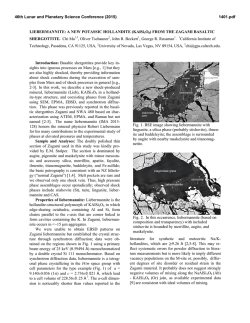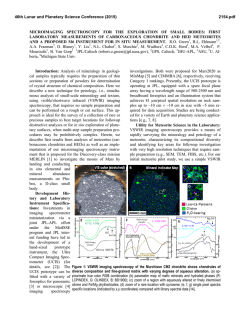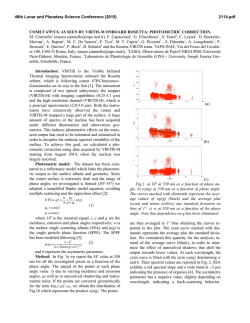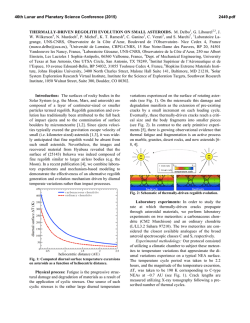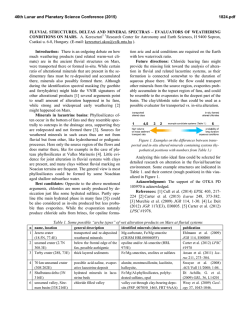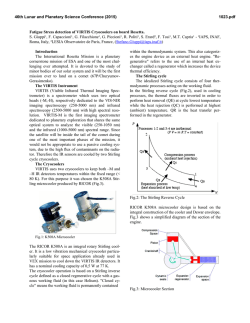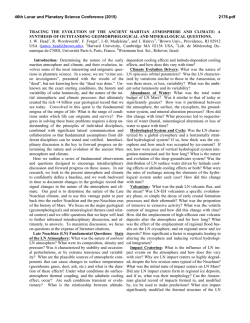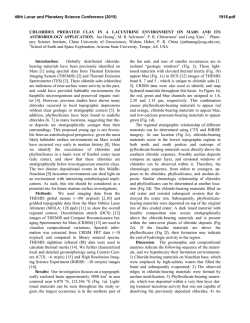
ARAM DORSUM: A NOACHIAN INVERTED FLUVIAL CHANNEL
46th Lunar and Planetary Science Conference (2015) 1321.pdf ARAM DORSUM: A NOACHIAN INVERTED FLUVIAL CHANNEL SYSTEM AND CANDIDATE EXOMARS 2018 ROVER LANDING SITE. M. Balme1, P. Grindrod2, E. Sefton-Nash2, J. Davis3, S. Gupta4, P. Fawdon1, P. Sidiropoulos5, V. Yershov5, & J-P. Muller5. 1Dept. of Physical Sciences, The Open University, Milton Keynes, UK, 2Dept. of Earth and Planetary Sciences, Birkbeck, University of London, UK. 3Dept. of Earth Sciences, University College London, UK. 4Dept. of Earth Science & Engineering, Imperial College, London, UK, 5Mullard Space Science Laboratory, University College London, UK. Introduction: The search for life on Mars is a cornerstone of international solar system exploration. In 2018, the European Space agency will launch the ExoMars Rover to further this goal. The Rover’s key science objectives [1] are to: 1) search for signs of past and present life on Mars; 2) investigate the water/geochemical environment as a function of depth in the shallow subsurface; and 3) to characterise the surface environment. ExoMars will drill into the sub-surface to look for indicators of past life using a variety of complementary techniques, including assessment of morphology (potential fossil organisms), mineralogy (past environments) and a search for organic molecules and their chirality (biomarkers). The choice of landing site is vital if the objectives are to be met [1]. It must: (i) be ancient (≥3.6 Ga); (ii) show abundant morphological and mineral evidence for long-term, or frequently reoccurring, aqueous activity; (iii) include numerous sedimentary outcrops that (iv) are distributed over the landing region (the typical Rover traverse range is a few km, but ellipse size is ~ 100 by 15 km). ‘Engineering constraints’ also apply, including: (i) latitude limited to 5º S to 25º N; (ii) maximum altitude of the landing site 2 km below Mars’s datum; and (iii) few steep slopes within the ellipse. In 2014, two international workshop were held to discuss potential landing sites. The outcome of these workshops was a shortlist of four possible sites: Aram Dorsum, Hypanis Delta, Mawrth Vallis, and Oxia Planum. We proposed the Hypanis and Aram Dorsum sites and led the scientific presentations for these sites at the Workshops. Here, we present the science case for Aram Dorsum – the case for Hypanis is made in [2] Overview: The Aram Dorsum site in western Arabia Terra (Fig. 1) is situated about half way between Meridiani Planum and the dichotomy boundary, where Arabia Terra meets the northern lowlands. Aram Dorsum itself is a flat-topped, branching, sinuous ridge-like feature that is surrounded by smoother marginal materials (Figs. 2, 3). We interpret Aram Dorsum to be a former fluvial channel system that has been preserved in positive relief by differential erosion (Fig 3). Such features are fairly common on Mars [3], and are also wellstudied on Earth (e.g., Fig. 4 and [4]). Aram Dorsum is interesting in that it is overlain by overburden materials including both ejecta from nearby 10-50km diameter craters, and regionally-extensive, sedimentary layers [5] (Fig. 2). These materials are Noachian, so Aram Dorsum itself must be at least this old. Fig 1. Context MOLA map showing regional setting for the Aram Dorsum site (white box). Blue and purple mark the lowest regions, yellow and brown the highest. Fig 2. Aram Dorsum site and 2018 landing ellipse. Blue/green areas are Aram Dorsum or its marginal units. Flow is inferred to be East-to-West. Purple areas are regionally extensive, Noachian-aged sedimentary units that superpose all other units within the study area. Outliers of these units occur across the study areas and in the ellipse. Non-coloured areas are mainly local overburden material. Observations: The Aram Dorsum main channel system is sinuous to meandering and contains multiple channels. These are both laterally and also vertically 46th Lunar and Planetary Science Conference (2015) separated from one another (cf. Fig. 4), as shown by cross-cutting relationships and traces of older, now buried, channels alongside and underneath the main channel system. In the west of the study area, the channel system is a well-defined, single thread channel. In the east the plan-view pattern is more consistent with an anastomosing, or multi thread channel, sometimes separated by lozenge-shaped ‘islands’. The main channel system is superposed upon a smooth, low relief channelmarginal unit that is also overlain by local and regional overburden materials. Inliers of this unit are seen in erosional windows within the overburden materials. At HiRISE scale, the channel marginal unit contains smallscale (10-20m) polygonal fracture patterns. The channel marginal unit is also present around the four (or more) smaller, tributary inverted channel systems that are seen across the study area and feed into the main trunk. All of these smaller systems appear to be forming in or beneath the channel marginal unit. Fig 3. CTX mosaic showing the Aram Dorsum ridge system (black arrows). Smaller, tributary ridges (e.g., at white arrow) connect to the main trunk system. Interpretation: The presence of channels at different stratigraphic positions demonstrate that there was long-lived fluvial activity, not catastrophic flow. This is reinforced by the overall morphology of the channel, which is consistent with a river-like fluvial system, not a catastrophic flow. That channels are set within the channel marginal unit, as well as on top of it, suggests that the channel marginal unit is a sedimentary deposit. The main channel system is not braided, and there is little evidence of unconfined channel migration. Instead, there are several stable sinuous paths, with multiple lateral branches. This implies that, when the main trunk formed, the channel has competent banks and that chan- 1321.pdf nel migrated laterally by avulsions, or was anastomosing, rather than by unconstrained lateral ‘sweeping’. In the absence of land plants [e.g., 6], other mechanisms that could stabilise the banks include ice-cementation or a high clay content. Aram Dorsum is a Noachian-era, aggradational, multithread/sinuous river-system, including small tributaries and extensive flood plain-like marginal deposits. Fig. 4. Inverted channels in Utah, USA. Arrows show a stratigraphically distinct channel segment overlain by a younger channel, rather than a junction in the channel. After Williams et al., 2009 [4] Relevance to ExoMars Science Goals: Aram Dorsum displays clear evidence for the long-lived action of water in the Noachian (possibly even early/mid Noachian). Although the inverted channel likely contains mainly coarse-grained sedimentary outcrops, the channel marginal unit is probably fined-grained sediments, or could contain lenses and/or ‘islands’ of fine grained material suitable for preserving biosignatures. Importantly, the system has been exposed from beneath >100s of metres of overburden materials; outliers of such overburden are still present. Such burial/exhumation greatly benefits preservation of biosignatures. The areas of interest defined by the channel marginal units and inliers within the overburden cover a significant proportion of study area, so potential targets are distributed throughout the ellipse. References: [1] ESA ExoMars LSSWG (2013), http://exploration.esa.int/mars/53455-call-for-exomars2018-landing-site-proposals/ Ref: EXM-SCI-LSSESA/IKI-001 [2] Sefton-Nash, E. et al., (2015, this volume), LPS XLVI, Abstract #1414 [3] Pain et al. (2007) Icarus 190, 478-491 [4] Williams, R.M.E., et al. (2009) Geomorphology, 107, 300-315 [5] Hynek, B.M., et al. (2002), JGR 107, DOI: 10.1029/2002JE001891 [6] Cotter, E. (1978), in: Miall, A.D. (Ed.), Fluvial Sedimentology, Can. Soc. Pet. Geol. Mem. 5, 361–383.
© Copyright 2025
